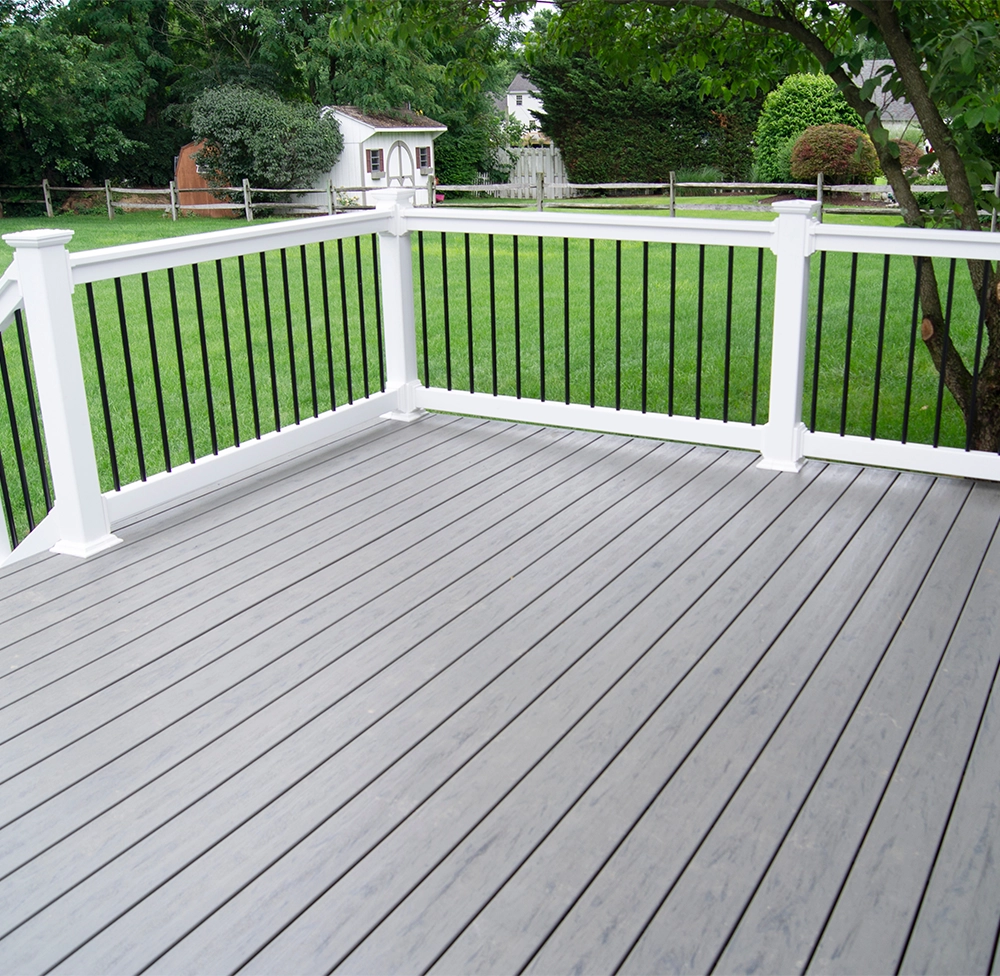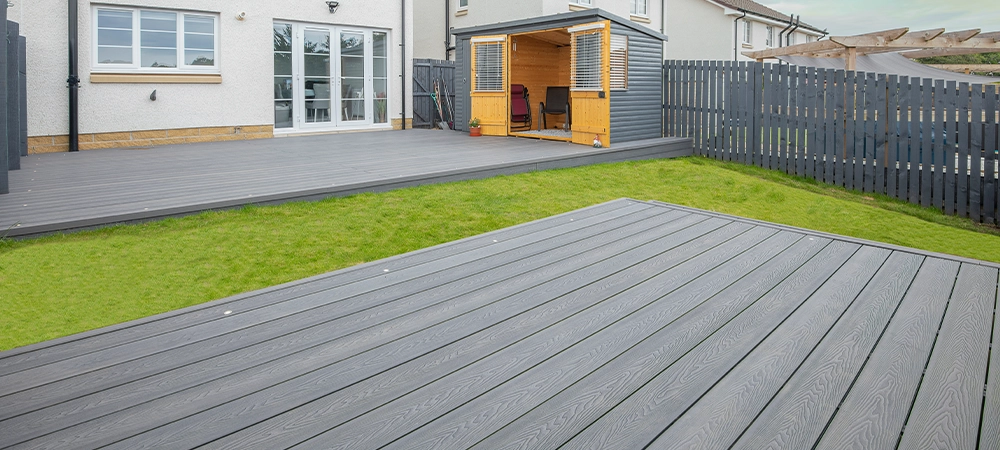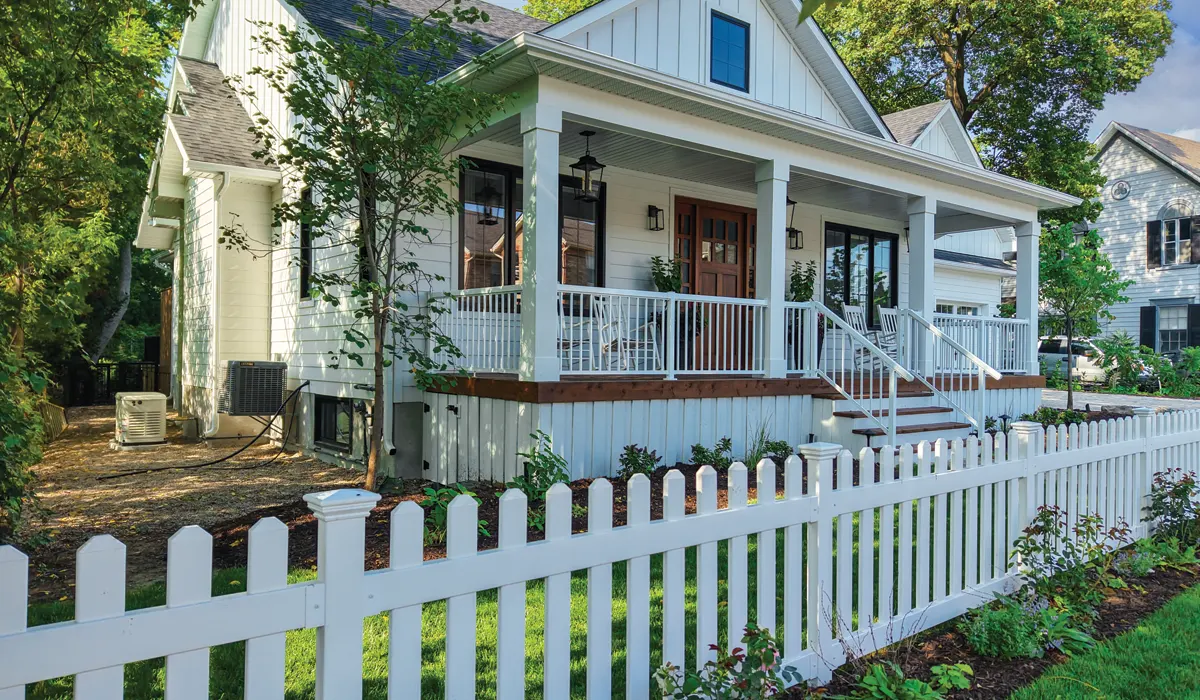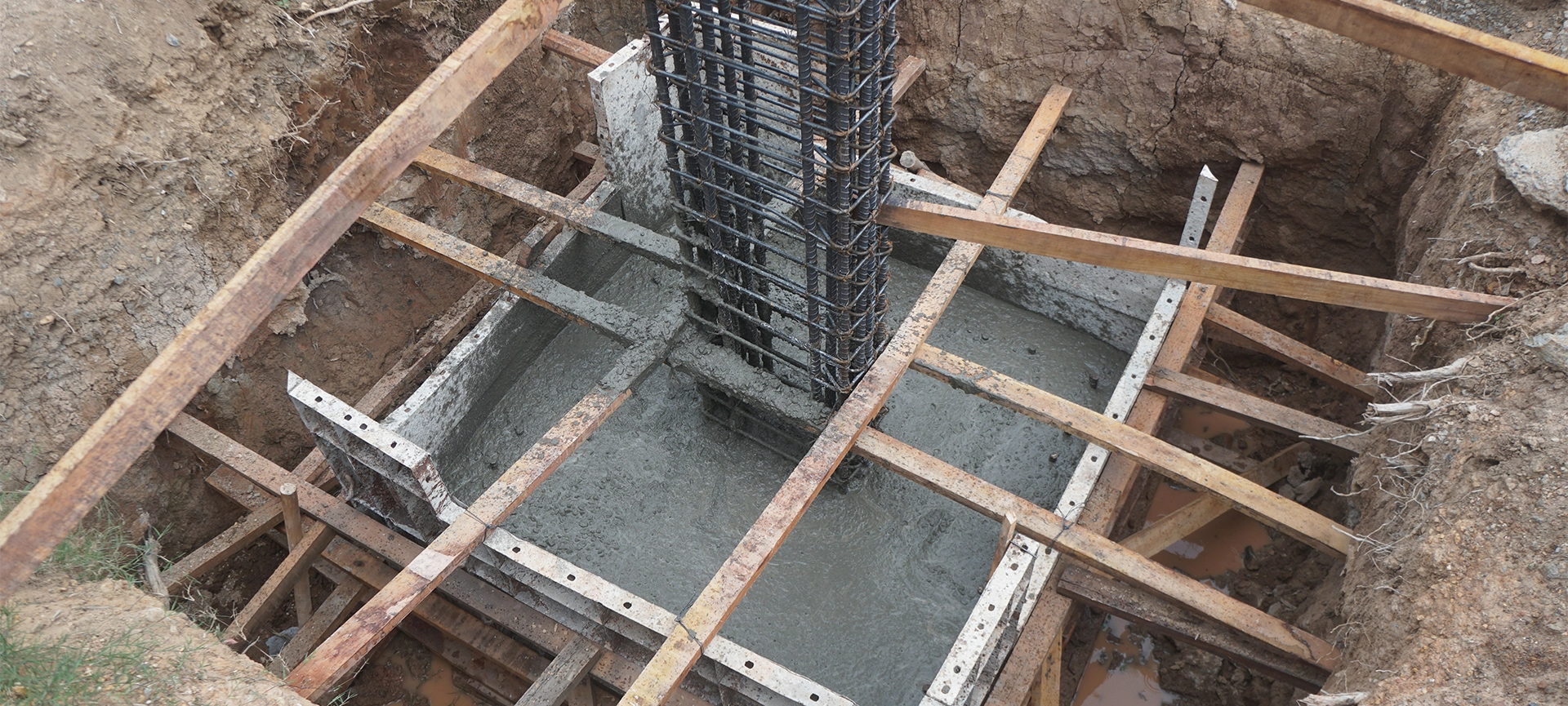
PVC vs. Composite Decking: What’s the Difference?
Building a deck is one of the best ways to expand your outdoor living space, but choosing the right material can be confusing. Homeowners often compare PVC vs composite decking, and while both offer low maintenance and long lifespan, their composition and performance differ in key ways.
This guide breaks down how each material is made, how it performs in Canadian weather, and which option may be right for your backyard.
Related Article: How Long Does a Deck Last? Lifespan by Material
What Is PVC Decking?
PVC (polyvinyl chloride) decking is made entirely from synthetic plastic, with no wood fibres. Each board is engineered for moisture resistance and long-term durability.
Manufacturers often coat PVC boards with UV-resistant finishes to prevent fading and add surface textures that mimic real wood. Because it’s a non-porous material, PVC doesn’t absorb water or need staining.

Key Features of PVC Decking
- 100% plastic composition prevents rot, splintering, and insect damage.
- Lightweight and easier to handle during installation.
- Highly resistant to mould, mildew, and moisture damage.
- Cooler underfoot options are available in light shades that reflect heat.
- Available in premium colours and embossed textures that resemble natural grain.
PVC is ideal for homeowners who want a sleek, modern deck that stays clean and functional with minimal effort.
What Is Composite Decking?
Composite decking combines recycled wood fibres and plastic polymers, creating a board that balances the natural look of timber with the resilience of synthetics.
Modern composite boards feature protective capping layers that improve stain resistance and reduce colour fading. This gives homeowners the charm of wood without the ongoing maintenance.
At Green Side Up Contracting, we specialize in Trex decking installation, a leading brand in capped composite decking known for its durability, fade resistance, and natural wood-grain finish.
Trex boards are engineered for long-term performance, making them a popular choice for Toronto homeowners who want a low-maintenance deck that looks great year after year.

Key Features of Composite Decking
- Wood-plastic blend offers an authentic appearance and solid weight.
- Capped technology protects against moisture and staining.
- Slip-resistant surfaces make it a safe choice around pools or patios.
- Available in wide colour ranges with realistic wood tones.
- Eco-friendly option made from recycled materials.
Composite decking appeals to homeowners who value a natural wood look but prefer to avoid sanding, staining, or sealing every year.
Related Article: TimberTech vs Trex: Which Composite Decking Is Right for You?
PVC vs. Composite Decking: Side-by-Side Comparison
| Feature | PVC Decking | Composite Decking |
|---|---|---|
| Material | 100% synthetic plastic | Blend of wood fibres and plastic |
| Appearance | Smooth or wood-grain finish | Highly realistic wood look |
| Weight | Lightweight | Heavier and denser |
| Moisture Resistance | Fully waterproof | Resistant but not waterproof |
| Maintenance | Wash occasionally with soap and water | Occasional cleaning may need mild stain removal |
| Durability | Excellent; resists rot and insects | Very good; slightly softer surface |
| Temperature | Can heat up under direct sunlight | Retains heat similar to natural wood |
| Cost | Higher upfront | Moderate cost |
| Best For | Wet areas, modern styles | Natural look, traditional decks |
Durability and Weather Performance
In the Greater Toronto Area, decks face both humid summers and freezing winters. PVC holds up exceptionally well against moisture, which makes it an excellent choice for poolside decks or damp areas. It also resists warping, splitting, and expansion during temperature swings.
Composite decking performs equally well when properly capped but may absorb a small amount of moisture through its wood fibres over time. That said, modern brands use advanced coatings that significantly reduce swelling or cracking.
For long-term performance, both materials are engineered to last 25–50 years when installed correctly and maintained as recommended.
Aesthetics and Design Versatility
Composite decking offers rich, natural colours and varied grain patterns that mimic real wood species like cedar or walnut. This makes it a top pick for homeowners who prefer a warm, classic finish.
PVC decking, on the other hand, suits modern or contemporary landscapes. The boards can be produced in sleek monochrome tones, coastal whites, or greys for a cleaner look.
Both materials are available in grooved and square-edge profiles, compatible with hidden fastener systems that create a seamless surface finish.
Related Article: How to Prevent Your Deck from Warping
Maintenance and Cleaning
Both PVC and composite decking are considered low-maintenance compared to traditional wood.
- PVC decks only need occasional washing with mild soap and water to remove dirt or pollen.
- Composite decks may need light scrubbing to clear surface stains or mildew buildup, especially in shaded areas.
Unlike wood, neither material requires staining, sealing, or annual refinishing, saving both time and long-term cost.
Cost Considerations
PVC decking typically costs more upfront due to its all-plastic composition and advanced manufacturing process. However, the reduced maintenance and longer lifespan often balance the investment.
Composite decking is more affordable at the outset and still provides outstanding longevity. The key is choosing a high-quality capped composite rather than uncapped versions, which can fade or stain over time.
When factoring in cleaning supplies, sealing products, and repairs over a 20-year span, both PVC and composite often cost less than maintaining natural wood.
Eco-Friendliness
Composite decking has a clear sustainability advantage. Its core is made from recycled wood and plastic waste, diverting tons of material from landfills.
PVC decking is fully recyclable at the end of its life, though its initial manufacturing is more energy-intensive. For environmentally conscious homeowners, composite offers a greener option, while PVC appeals to those prioritizing durability and longevity.
Installation and Structural Differences
PVC boards are lighter, which makes them easier for installers to handle and ideal for rooftop or second-storey decks. However, they expand and contract slightly more with temperature changes, so professional spacing and fastening are essential.
Composite decking is denser and feels more solid underfoot. It can be cut and worked using standard carpentry tools and tends to hold screws and fasteners more firmly.
Both materials are compatible with concealed fastening systems for a clean finish and require proper framing to ensure long-term stability.

Which Decking Material Is Right for You?
Choosing between PVC and composite depends on your priorities:
- If you want maximum durability, low water absorption, and a sleek look, PVC is a strong choice.
- If you prefer a natural wood aesthetic, eco-friendly design, and balanced cost, composite decking delivers lasting value.
For homeowners in the GTA, both options stand up well to Canada’s changing weather, provided they are installed by experienced professionals.
Related Article: Preparing Your Deck for Winter: Checklist
Your Deck, Built for Canadian Weather
A high-quality deck is more than a surface. It’s an extension of your home. Whether you’re drawn to the sleek finish of PVC or the warmth of composite, Green Side Up Contracting can design and build a deck that suits your lifestyle, complements your property, and withstands every Toronto season.
Ready to Build Your Dream Deck?
From concept to completion, Green Side Up Contracting delivers quality craftsmanship and expert guidance for every decking project. Whether you choose PVC or composite, you’ll enjoy a beautiful, low-maintenance space built to last.
Request your free consultation today to start transforming your backyard.
Frequently Asked Questions
Is PVC decking more durable than composite?
Yes. PVC decking offers superior resistance to moisture, mould, and insects. Composite is still very durable but may show light surface wear over time.
Which decking stays cooler under the sun?
Light-coloured PVC decks reflect heat better, making them cooler underfoot. Darker composites can retain more warmth in direct sunlight.
Can PVC or composite decking be painted or stained?
No. Both come pre-finished with protective coatings that don’t absorb paint or stain. Instead, choose from their available colour selections.
Which is more eco-friendly: PVC or composite?
Composite decking is generally greener since it uses recycled wood and plastic materials. PVC is recyclable but more energy-intensive to produce.
How long does each decking type last?
With proper care, both can last 25 to 50 years. PVC tends to maintain its appearance longer in damp or coastal environments.
Can these decking materials handle Canadian winters?
Yes. Both are engineered for freeze-thaw cycles common in Toronto. PVC has slightly higher resistance to moisture expansion and cracking.
Can I mix PVC and composite materials in one deck design?
Yes. Many homeowners combine both to balance appearance, performance, and cost; for example, using composite for the main surface and PVC for trim or fascia.



